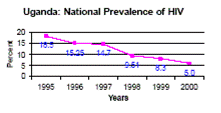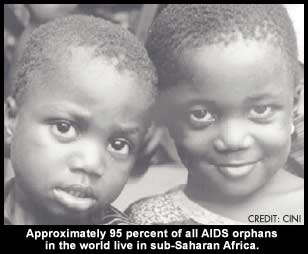|
|  |

It has been over two decades since the first case of acquired immune deficiency syndrome (AIDS) appeared in 1981, and its aetiological agent the human immunodeficiency virus (HIV) was identified in 1982. The adverse impact of the disease has affected over one million people alone in Uganda, and approximately 120,000 have developed AIDS. To date, there neither is a cure nor a vaccine against the disease. Despite this, however, a great effort to suppress the spread of the disease continues.
In 1982, the first HIV/AIDS case was identified in Uganda, along the shores of Lake Victoria. With a growing population, estimated to be approximately 24.6 million (UNAIDS), there are 1,050,555 million people living in Uganda infected with the disease; and nearly 80% of those infected are between the ages of 15-45 years. As early as 1987, the Government of Uganda recognized that the magnitude and impact of the HIV/AIDS epidemic was surely an issue that needed to be addressed. Interventions to prevent further spread of the disease have been chiefly centered on changes in behaviour (i.e., condom use). In Uganda, HIV/AIDS is more prevalent in particular socio-demographic categories that are labeled as high risk groups; these groups may include young, single women, commercial sexual workers, long distance truck drivers, and urban residents.
Sentinel Surveillance Surveys are conducted annually and show that there is a strong declining in HIV rates (refer to Figure 1). Since the recognition of this epidemic, the government has actively addressed complacency by mobilizing all possible parties, including political leaders, such as Ugandas current president Yoweri Kaguta Museveni, and the immediate community including civil society and traditional healers.
| Fig. 1 |

|
|
 |
|
A report by the Ugandan Health Ministrys STD/AIDS Control Programme (STD/ACP) showed that HIV infection was declining in parts of the country. In 1996, a report released to the media indicated that Ugandans have significantly changed their sexual behaviour to avoid infection (i.e. increased condom use). With the advocacy of HIV/AIDS eradication, Ugandas prevalence rate has dropped from its peak of 18.5% (in 1996) to 5.0% (in 2002), proving to truly be a success story.

|
 |
|
 |
|
 |
|
|
|
In order to accurately and comprehensively assess the severity of the HIV/AIDS epidemic in Uganda, a cultural approach must be utilized. Culture, by definition, is a complex set of distinctive spiritual, material, intellectual and emotional features that characterize and define a society or social group. In addition to arts and letters, it encompasses ways of life, the fundamental rights of the person, value system, traditions and beliefs1. Culture encompasses two essential elements:
(i) it is not the possession or accomplishment of an individual, but defines a way of being together with others; it is essentially social
(ii) it is not made up of a given range of activities, but consists of all and only those activities through which a society defines and identifies itself (UNESCO, 1997:30).
From this definition, it would therefore follow that a cultural approach to HIV/AIDS epidemic is one in which all activities undertaken as a society pertaining to prevention, treatment and care are
identified for their contributions in containing the scourge. This view is consistent with a perspective which views culture to be a focal point where a society meets in order to think about itself and determine collectively what sort of society it is and wants to be (UNESCO 1997:31).

|
| link to UNESCO |
|
|
|  |

